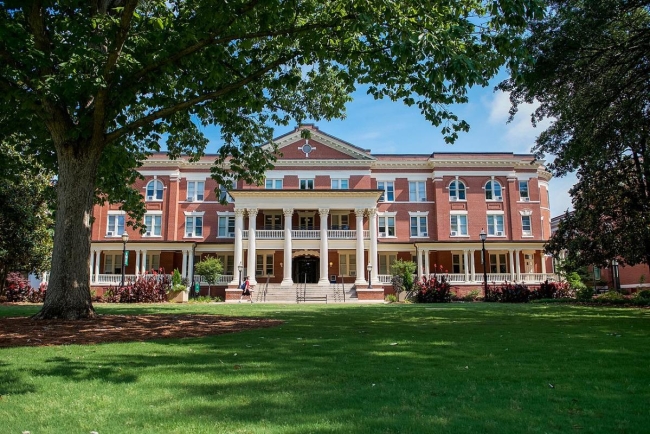You have /5 articles left.
Sign up for a free account or log in.

Wikimedia Commons
In late August, alarm bells sounded about Georgia College and State University. The public liberal arts college had seen about 7 percent of its on-campus student body infected with COVID-19 since the beginning of the month. The administration continued with in-person classes anyway.
Since then, while new daily infections have slowed, now 10 percent of on-campus students have caught COVID-19 since the beginning of August. The college has seen 645 cases in that period, according to a public dashboard, despite having fewer than 7,000 students enrolled.
The university did not test students prior to their arrival and only today began offering any testing on campus. There is no systematic surveillance testing of asymptomatic students. Students who become ill or have been in contact with someone who has tested positive are expected to travel home to isolate. Quarantine housing is only available for the few who cannot return home, such as international or independent students, a marketing communications specialist with the college said. Those with the virus must travel home.
Instructors say they’ve seen up to one-third of their students in quarantine or isolation and the university has not required any online course resources be provided to those students. The campus newspaper has seen at least three editors sick with the virus or exposed, all in different sections.
“It’s true the administration has taken big leaps within the campus to enforce social distancing and mandate masks and provide wipes in class and provide sheets for the teachers to stand behind,” said Avery James, a GCSU master's student and instructor, “but this has clearly not been enough.”
Though new student infections have been decreasing, employee cases have only been growing. There have so far been six employee cases in September, an increase from four in August. Faculty have only been permitted to teach online if they are highly vulnerable to COVID-19.
“The way the university has gone about this has been ham-handed at best and criminally negligent at worst,” said one faculty member who wished to remain anonymous. “Chances are pretty good someone’s going to die of this.”
Though faculty and other employees voiced their concerns at a “die-in” on Aug. 28, one faculty member said employees have since felt defeated. The administration has not made any visible policy changes since then.
"I feel anxiety for my students," said James. "I feel anxiety for the community outside GCSU."
Public health guidance on testing asymptomatic students, upon entry or at planned intervals, has been mixed. The Centers for Disease Control and Prevention have not recommended such measures, but studies from a variety of sources have underscored their importance.
On quarantine and isolation housing, guidance has been more emphatic.
“Campuses must proactively identify appropriate residential spaces and reserve those spaces in the event of needed isolation or quarantine of a student(s),” reads guidance to colleges from the American College Health Association. “If on-campus housing is nonexistent, unavailable, or unfeasible, the college/university should identify off-campus options for the isolation and quarantine of residential students.”
Students in residence halls at Georgia College are also being housed in double rooms, which is similarly against guidance from ACHA.
A recent newsletter from the Office of Health Promotion at Georgia College dedicated one-quarter of one page, out of five pages, to COVID-19.
A Positive Outlook
Not everyone at Georgia College is pessimistic about the situation.
Eric Boyd, a junior and editor of the college newspaper, The Colonnade, said that while many students are sick, there hasn’t been a strong sense of fear among the student body.
“The fact that we have a problem shows there’s nowhere that anyone’s really afraid to be,” he said.
Mask compliance is generally good, he said, and people are socially distanced in class.
Jehan El-Jourbagy, a professor of business law and ethics at the college, expressed a similar sentiment.
“The college has expended tremendous effort to comply with health recommendations, and students sit at least six feet apart. Signs are everywhere,” she wrote in a letter to the editor of Inside Higher Ed. “As students walk on campus, they are wearing masks.”
El-Jourbagy said everyone at Georgia College is doing their best and many instructors, such as himself, are providing online materials to students who are isolating, despite no requirement from the administration to do so.
"In the first few days, the classes did get thinner and thinner. I am, however, observing students emerging from isolation or quarantine, and the numbers do not appear to be growing exponentially among students," she wrote.
The Office of Student Affairs has created a team of staff members to check in on students who are in quarantine or isolation.
“The university’s leadership cares deeply for students who find themselves in academic, emotional, or physical distress. This is the spirit behind the creation of our COVID CARE Response Team,” said Aubrie Sofala, a marketing communication specialist with the college, via email.
The college published a story on Tuesday explaining that the response team can bring food to students who have no one else to call on, or provide a listening ear for anxiety about missing class.
“For students in quarantine, faculty members are working to make sure learning can continue until they are able to return to campus safely,” Sofala said via email.
Boyd said there are things the college could improve, but he feels a lot of the problem has come from student gatherings and parties off-campus, something he’s not sure the administration can be held responsible for.
“So far I’m having a great semester,” he said. “Personally I really missed getting to be on campus.”
The college communications office did not respond to a request for comment about the high number cases or questions about how many students are in quarantine, how students are housed or if any alternative plans or changes are being discussed.








